These days, no fancy bakery display is complete without an array of French macarons. And who can resist picking up a few of these airy cookies filled with rich buttercream? You can certainly buy dozens to take home, but you can also learn how to make a macaron recipe yourself so you can enjoy them anytime you’re feeling indulgent and fancy.
What are French macarons?
These cookies are an enigma: chewy yet crisp, airy but rich. Even if you’ve enjoyed these cookies before, you may still be asking what macarons are exactly.
Macarons (which are not the same as macaroons) are meringue-like cookies made with almond flour. These light cookies are baked until crisp on the outside and chewy on the inside. The cookies are usually filled with buttercream, though you may see versions with jam, ganache or citrus curd.
Ingredients for French Macarons

- Almond flour
- Confectioners’ sugar
- Egg whites
- Superfine sugar
- Salt
Buttercream:
- Unsalted butter
- Confectioners’ sugar
- Heavy whipping cream
- Vanilla extract
- Salt
- Optional: gel food coloring
Directions
Step 1: Pulse the almond flour
Use a kitchen scale to measure out the ingredients. Macarons require precise measurements, and a scale ensures you’ll get all the right proportions.
Once your ingredients are measured, pulse the almond flour and 3 tablespoons of confectioners’ sugar together until very fine. Then pass the mixture through a fine mesh sieve and get rid of any large pieces that remain. This may seem like overkill, but a fine texture is essential. Even fine almond flour will have large bits in it. Pulsing in the food processor and sifting will lighten the mix and remove any chunks.
Test Kitchen Tip: Choose almond flour that’s processed without the almond skins. These skins can cause the flour to have an imperfect consistency.
Step 2: Whisk egg whites
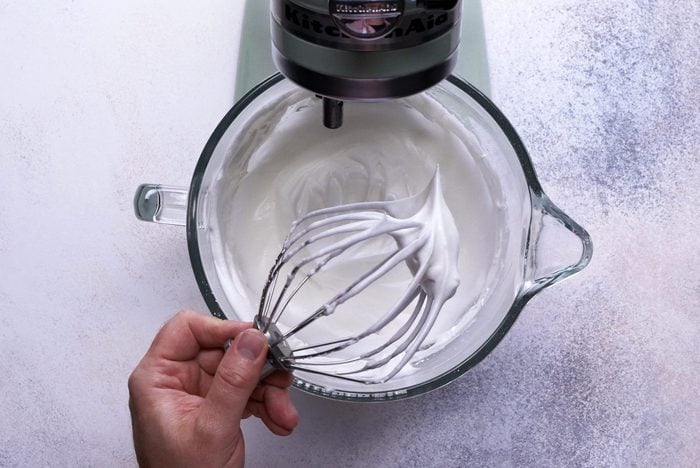
Next, get out your stand mixer fitted with the whisk attachment. Make sure the bowl and the whisk are squeaky clean for success with this step.
Add the egg whites and salt to the bowl and whisk on medium-low speed until frothy. Then slowly add the superfine sugar. Take your time; this process will take about 2 minutes.
Add in the remaining confectioners’ sugar and bump up the speed to high. Whisk until the meringue is glossy and stiff peaks form—about another 2 to 3 minutes.
Test Kitchen Tip: Superfine sugar dissolves better in the meringue, so make sure to use that over granulated sugar.
Step 3: Fold
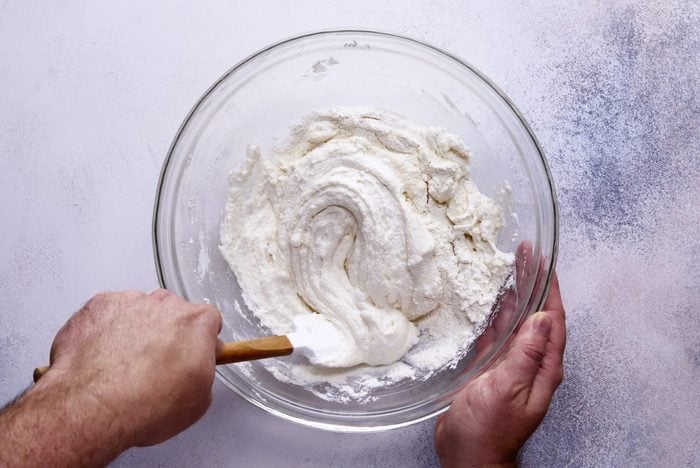
This is the first major hurdle when learning how to make a macaron recipe: getting the folding just right. If you’re not familiar, folding is a gentle way of incorporating a heavy mixture into a light, airy mixture.
Add your meringue into a large, wide-mouthed bowl. You’ll need the space.
Add in about a third of the almond flour mixture into the meringue and fold lightly. Start at the outside, scrape along the bottom of the bowl towards you with a flexible spatula, continue up the side and scoop the mixture over the top. When that first bit of almond flour is well incorporated, add in the next third of the flour mixture and then the last third.
As you work, turn the bowl and just continue to work slowly and carefully starting along the outside of the bowl. You do not want to deflate the egg whites! Egg whites give these cookies their signature texture.
In the end, you don’t want to see any large bits of egg whites. Undermixed batter can cause the cookies to crack. Your finished macaron batter should be uniform. When you pull your spatula through the batter, you’ll see the bottom of the bowl before the batter slowly flows back together. Our Test Kitchen compares it to “slow lava.”
Step 4: Pipe the macaron shells
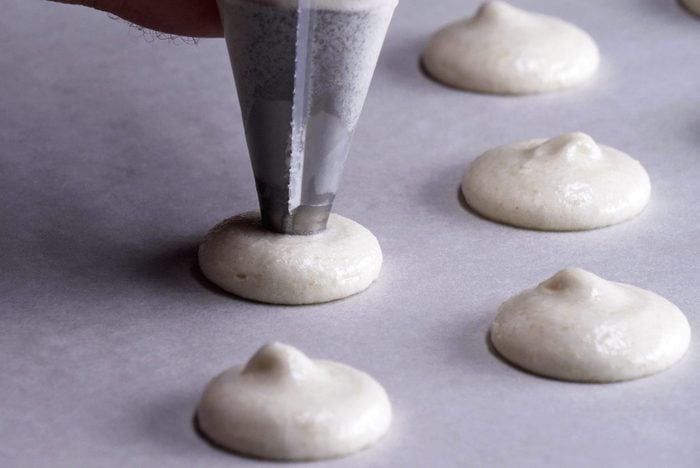
Transfer your macaron batter into a piping bag fitted with a basic round piping tip; something like this #1A tip works well.
Take your cookie sheet outfitted with a pastry mat (with the outlines already marked) or parchment paper and start piping. Keep the bag and the tip perpendicular to the cookie sheet. Keeping this posture is critical for evenly shaped macarons.
If you don’t have a pastry mat with the outlines already marked, you can draw your own template onto a sheet of parchment. Macarons are generally about 1-1/2 to 2 inches across, so break out that kitchen ruler and get tracing. If you need a guide, trace around the lip of a shot glass; it’s the perfect size.
Test Kitchen Tip: Use a cookie sheet (that’s a baking sheet without a lip) as compared to a rimmed baking sheet. A rim can cause the cookies to not rise properly later.
Step 5: Tap and rest
With your cookies perfectly piped, give the cookie sheet a tap on the counter to release any air bubbles inside the batter. If you notice any remaining large air bubbles, you can pop them carefully with a toothpick.
Then walk away. Once they’re piped it’s important to let them sit so they can form a shell.
On a dry day, this will take about 15 minutes; but if humidity is high, it may take over an hour. The macarons are ready to bake when you tap the top of a shell and it’s no longer tacky.
Step 6: Bake
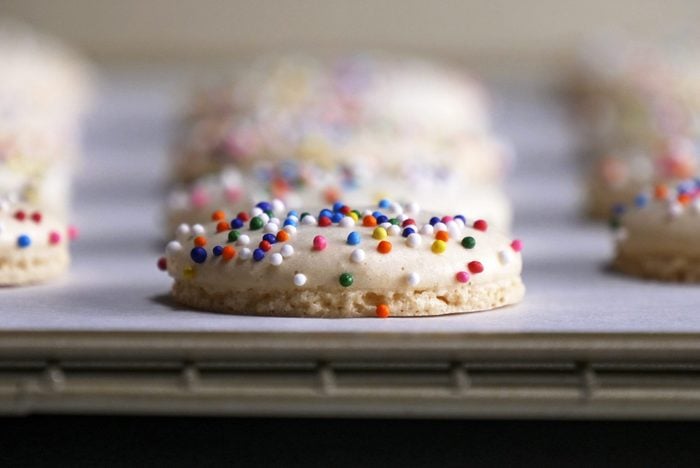
Before you pop your cookie sheet of macaron shells in the oven, check your oven’s temperature. Because these cookies are a bit more temperamental than the standard chocolate chip, precise temperature is key. Use an affordable oven thermometer to verify the temp.
Once you’re sure that your oven is truly at 300°F, bake the cookies one tray at a time for 14 to 16 minutes.
Remove them from the oven and allow the cookies to cool completely on the baking sheet—no need to move them to a wire rack. These cookies are fragile, so handling them as little as possible is best.
You’ll know when they’re properly baked when they’re slightly crispy and they release easily from the parchment paper. Macarons that have been baked correctly will also have a shiny top without cracks and a lip around the bottom edge of the cookie that pastry chefs refer to as feet.
Step 7: Make the filling
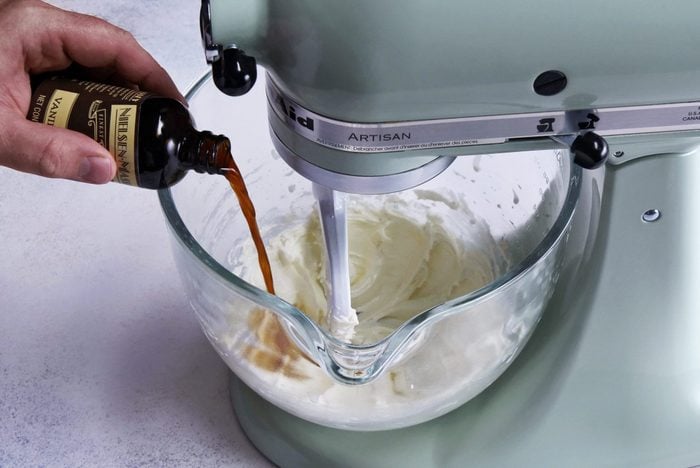
Once your shells are done baking, you can move on to making a lush buttercream filling. After baking the macaron shells, this part is a breeze!
Start by beating softened butter in the bowl of a stand mixer (your hand mixer will also work here). Slowly add in the confectioners’ sugar until well incorporated. Then add in the cream, vanilla extract and a pinch of salt. If you’re looking to add color, this is the time to add food coloring. Beat the mixture until the buttercream is velvety smooth.
Add the buttercream to a pastry bag fitted with a basic round tip.
Test Kitchen Tip: Vanilla extract is the go-to for flavoring frosting, but feel free to use other extracts as well. Peppermint, lemon or almond extract are all yummy substitutions.
Step 8: Put it all together
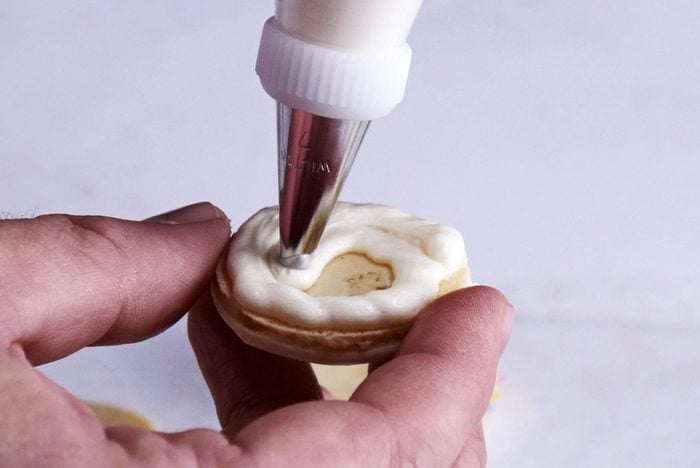
All that’s left is to pipe a bit of buttercream onto half of the macaron shells. Sandwich the cookies together to make perfect macarons. You can enjoy them right away or cover and refrigerate until you’re ready to indulge.
How do you store macarons?
Because of the buttercream filling, macarons are best stored in the refrigerator. Store them in an airtight container, placing layers of parchment between layers if stacking.
These cookies are best enjoyed at room temperature. When you’re starting to crave dessert, let them sit out at room temperature for about 30 minutes before diving in.
Macaron Tips

Can you make macarons without almond flour?
Almond flour is traditional for this type of cookie, but you can use alternatives! Swap out the almond flour for another type of nut flour like hazelnut, pistachio or pecan flour. Follow the exact same steps as you would for a traditional macaron (pulsing in a food processor and sifting).
If you don’t have nut flour on hand, you won’t be able to make macarons. Nut flour is essential for making these cookies. Fortunately, finding almond flour is easier than ever. Many big box stores carry it and you can always find it online.
How long does it take to make macarons?
Macarons are one of those all-day baking projects, so don’t attempt to make these after dinner one evening! Set aside a good three hours to make these cookies. There will be some downtime with allowing shells to rest and bake, though.
Can you dye macarons?
Yes, you can add food coloring to macaron batter. But before you rummage in your baking supplies, take this bit of advice to heart: Always use gel food coloring, never liquid.
Liquid dye will alter the consistency of the batter which you do not want with a fussier recipe like this. Gel coloring, on the other hand, will add potent color without compromising the consistency.
What if your macarons don’t have “feet?”
The foot of a macaron is that ruffled ridge along the outside edge. If your macarons don’t have that edge and lift, it’s because they didn’t rest long enough before going into the oven.
Humidity has a major effect on how the shells dry. On a cool, dry day in February, the shells can dry in 15 minutes; on a humid July day, it could take an hour or more. Make sure to test the dryness of the shells by tapping the top with your finger. They are dry enough to bake when the top is no longer tacky.
Without this feature, your macarons will not have the right texture. You’ll want to start again.
What if the macaron shells are hollow?
Hollow shells are also a common macaron mistake. Hollow shells (versus ones that are crisp outside and chewy inside) are the result of overmixed batter. Be very mindful as you fold.




















